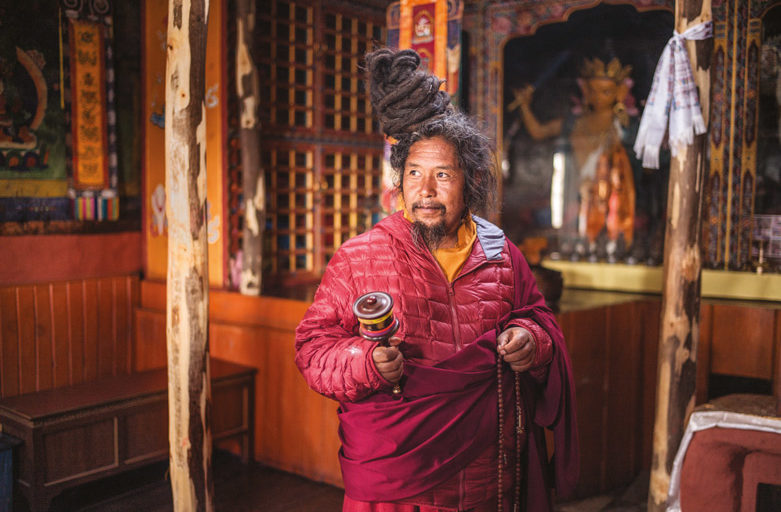Q: Today we have inaugurated the Mila Rechen Center, what are Rinpoche’s expectations for the Mila Center and the Mila Rechen Center?
A: My expectations are simple but profound: simply, through the creation of these two associations, that in future peace of mind will diffuse to all beings living on Earth, that we are able to spread a great joy and happiness, in particular to people in France, and that this happiness can be accessible. This is my only hope, to be realized through the creation of these two centers.
Q: You open this center in France, but people from all over Europe are invited here, I guess.
A: I travel to many European countries to teach, and each time I can stay very briefly. Each time my European students ask me to come more often or to stay longer and until now I couldn’t fulfil their requests, I couldn’t materially do that – so, by founding this center in a central country like France, I hope there will be a moment, in summer for instance, for several weeks, when everybody is invited to a huge gathering and there will be teachings, practices and rituals. For example it will be once in the summer, over several days, and maybe once in another season, like winter or spring, and everybody will be invited. All the people I meet in Europe, with whom I can’t stay as long as I wish, will be able to gather here. Therefore everybody is invited, of course.
Q: Khenpo Tashi, in this center you will teach meditation: could you tell us what’s the purpose of meditation?
A: What is called meditation, “gom’’ in Tibetan, which means “to get used to, to cultivate’’, is our main practice. It’s actually the practice also called mind training. This training, when you have all kinds of problems, all kinds of psychological, emotional, cognitive disturbances but also physical problems, it’s a practice that aims to pacify the mind in the midst of the difficulties, to bring calm and inner peace. This is the main purpose of our actual practice, meditation.
Q: Can everybody attend? Must one be a Buddhist, or not-Buddhist, to come and follow your teachings on meditation?
A: Learning meditation is clearly accessible to everybody, open to everybody – in Tibetan they say “all classes, all races’’ – all human beings.
And not only that, but what you see in the life story of Jetsun Milarepa, for instance, is that he taught dogs, chamois, deer, wild animals. He taught the 6 yogas of Naropa to animals, he even taught Mahamudra to animals, because they were qualified to receive a teaching, as they had a mind and they wanted to pacify it.
Therefore, as long as one has got a mind and wants to pacify it, one is qualified to have access to teachings.
If somebody has a problem on the physical level, he/she goes to see a doctor to get a diagnosis and a cure, he goes to the hospital; they won’t say, “No, this is only for Buddhists, or only for non-Buddhists, or only for that class of beings, because others can’t be treated by these medicines…’’ No. There are medicines that treat the body, it’s as simple as that.
In our case, we have medicines, so to speak, that cure the mind of its sicknesses, its pains, its suffering, that can pacify the mind. So, as long as one has a mind, one is invited, one is welcome, one has everything he needs.
Q: Khenpo Tashi, you are renowned for your teachings on Mahamudra. What is Mahamudra?
A: What is called Mahamudra, translated as Great seal or Great symbol, means just this: what is the mind, the nature of the mind, the fundamental characteristics of the mind, what it really is. In this physical body there is a mind, which is clearly connected to the body. Once you know the mind directly, once the mind presents itself to itself, it recognizes itself (in the Mahamudra it’s all about presentation, introduction, confrontation with the nature of the mind), once one can say, “The mind is this’’ with a sense of certainty, then there is no other Mahamudra. This is the very essence of the Great seal, the methods.
Q: Have you planned a teaching program for the next three years? Will there be meditations, long sessions in retreats, special teachings? Have you already got some ideas?
A: It’s simple. In the next three years the center will grow, many people will attend as students, so the teachings will be adjusted to individual needs. It means there will be students who will get instructions for dream practice, the dream yoga; others will receive special instructions for the meditation of clear light; there are other students who will be more suited for tummo practice. So this is my plan, in future I’ll give more personal instructions according to individual needs. Each one will know what to do.
Q: Now the center is very small, it’s a work in progress. How can people help to build it? Giving money, for instance, or working in it, or contributing their ideas?
A:
Actually there is so much to do, so much work, therefore if people can provide financial help that’s great, because by helping the center they help their country, they help themselves, they help beings to be more peaceful, more joyful, happier. They help to spread happiness, so if they can help the association financially, that’s very good.
Then, they can provide physical help, coming here to do some work, to help with the renovation of the house, or in the garden, in the weekend or during the week if they have some free time. They can also help with the administration, if there’s some paperwork to do. They can bring their support and contribution according to their abilities, so any kind of help is welcome.

